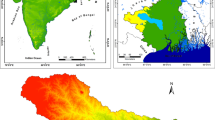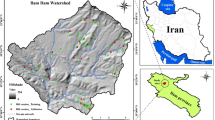Abstract
Severe rainfall causes soil to erode, which has far-reaching effects on the natural environment and anthropogenic activity. It is regulated by the interplay of “lithology, orography, hydrography, land use, and vegetation” and is dependent on rainfall distribution (e.g., “intensity, duration, the cumulative per event”). More than 75 percent of India's yearly rainfall is brought on by the monsoons, making India a prime example of a country with a monsoonal climate. The monsoon season is the apex of all erosional rainfall. Therefore, changes in the frequency and volume of the monsoon's rain will result in corresponding shifts in the season's erosivity patterns. So, identifying vulnerable regions through proper modeling is one of the essential tasks in soil erosion research. In this study, the MaxEnt, RF, SVM, and SLR model has been considered for estimating erosion susceptibility. The overall result has been confirmed, and we found that the MaxEnt model is optimal to other models in this study in terms of performance. This kind of research is helpful to the decision-maker in determining whether or not to use these strategies for preventing soil erosion and achieving the desired results. The main novelty of this work is the use of an appropriate machine learning method to evaluate soil erosion susceptibility for the first time in the study area, taking into account the most significant feasible number of causal factors.









Similar content being viewed by others
References
Akgun A (2012) A comparison of landslide susceptibility maps produced by logistic regression, multi-criteria decision, and likelihood ratio methods: a case study at İzmir, Turkey. Landslides 9:93–106
Alewell C, Borrelli P, Meusburger K, Panagos P (2019) Using the USLE: chances, challenges and limitations of soil erosion modelling. Int Soil Water Conserv Res 7:203–225
Arabameri A, Chen W, Loche M, et al (2019) Comparison of machine learning models for gully erosion susceptibility mapping. Geoscience Frontiers
Awad M, Khanna R (2015) Support vector machines for classification. In: Efficient learning machines. Springer, New York pp 39–66
Bai S-B, Wang J, Lü G-N et al (2010) GIS-based logistic regression for landslide susceptibility mapping of the Zhongxian segment in the Three Gorges area, China. Geomorphology 115:23–31. https://doi.org/10.1016/j.geomorph.2009.09.025
Balabathina VN, Raju R, Mulualem W, Tadele G (2020) Estimation of soil loss using remote sensing and GIS-based universal soil loss equation in northern catchment of Lake Tana Sub-basin, Upper Blue Nile Basin, Northwest Ethiopia. Environ Syst Res 9:1–32
Batty M (1974) Spatial entropy. Geograph Anal 6:1–31
Boardman J, Favis-Mortlock D, Foster I (2015) A 13-year record of erosion on badland sites in the Karoo, South Africa. Earth Surf Proc Land 40:1964–1981
Borrelli P, Robinson DA, Fleischer LR et al (2017) An assessment of the global impact of 21st century land use change on soil erosion. Nat Commun 8:1–13
Brown SC, Lester RE, Versace VL et al (2014) Hydrologic landscape regionalisation using deductive classification and random forests. PLoS ONE 9:e112856
Burges CJC (1998) A tutorial on support vector machines for pattern recognition. Data Min Knowl Disc 2:121–167
Cama M, Schillaci C, Kropáček J et al (2020) A probabilistic assessment of soil erosion susceptibility in a head catchment of the Jemma Basin, Ethiopian Highlands. Geosciences 10:248
Charrua AB, Bandeira SO, Catarino S et al (2020) Assessment of the vulnerability of coastal mangrove ecosystems in Mozambique. Ocean Coast Manag 189:105145
Chuenchum P, Xu M, Tang W (2019) Estimation of soil erosion and sediment yield in the Lancang-Mekong river using the modified revised universal soil loss equation and GIS techniques. Water 12:135
Conoscenti C, Angileri S, Cappadonia C et al (2014) Gully erosion susceptibility assessment by means of GIS-based logistic regression: a case of Sicily (Italy). Geomorphology 204:399–411. https://doi.org/10.1016/j.geomorph.2013.08.021
Cristianini N, Shawe-Taylor J (2000) An introduction to support vector machines and other kernel-based learning methods. Cambridge University Press, Cambridge
Csáfordi P, Pődör A, Bug J, Gribovszki Z (2012) Soil erosion analysis in a small forested catchment supported by ArcGIS Model Builder. Acta Silvatica Et Lignaria Hungarica 8:39–55
Cunningham P, Cord M, Delany SJ (2008) Supervised learning. Machine learning techniques for multimedia. Springer, New York, pp 21–49
Debanshi S, Pal S (2020) Assessing gully erosion susceptibility in Mayurakshi river basin of eastern India. Environ Dev Sustain 22:883–914. https://doi.org/10.1007/s10668-018-0224-x
Elith J, Phillips SJ, Hastie T et al (2011) A statistical explanation of MaxEnt for ecologists. Divers Distrib 17:43–57
Erener A, Düzgün H (2012) Landslide susceptibility assessment: what are the effects of mapping unit and mapping method? Environ Earth Sci 66:859–877
Goel E, Abhilasha E (2017) Random forest: a review. Int J Adv Res Comput Sci Softw Eng 7:251–257. https://doi.org/10.23956/ijarcsse/v7i1/01113
Gregori-Puigjané E, Mestres J (2006) SHED: Shannon entropy descriptors from topological feature distributions. J Chem Inf Model 46:1615–1622
Hosseinalizadeh M, Kariminejad N, Chen W et al (2019) Gully headcut susceptibility modeling using functional trees, naïve Bayes tree, and random forest models. Geoderma. https://doi.org/10.1016/j.geoderma.2019.01.050
Irvem A, Topaloğlu F, Uygur V (2007) Estimating spatial distribution of soil loss over Seyhan River Basin in Turkey. J Hydrol 336:30–37
Jha V, Kapat S (2009) Rill and gully erosion risk of lateritic terrain in South-Western Birbhum District, West Bengal, India. Sociedade Natureza 21:141–158
Kayitesi NM, Guzha AC, Mariethoz G (2022) Impacts of land use land cover change and climate change on river hydro-morphology—A review of research studies in tropical regions. J Hydrol 128702
Keesstra SD, Bouma J, Wallinga J, et al (2016) The significance of soils and soil science towards realization of the United Nations Sustainable Development Goals. Soil
Kumar N, Singh SK, Singh VG, Dzwairo B (2018) Investigation of impacts of land use/land cover change on water availability of Tons River Basin, Madhya Pradesh, India. Model Earth Syst Environ 4:295–310
Lee S, Sambath T (2006) Landslide susceptibility mapping in the Damrei Romel area, Cambodia using frequency ratio and logistic regression models. Environ Geol 50:847–855
Liaw A, Wiener M (2002) Classification and Regression by randomForest. R News
Ma Q, Su Y, Guo Q (2017) Comparison of canopy cover estimations from airborne LiDAR, aerial imagery, and satellite imagery. IEEE J Sel Top Appl Earth Observ Remote Sens 10:4225–4236
Madarász B, Jakab G, Szalai Z et al (2021) Long-term effects of conservation tillage on soil erosion in Central Europe: a random forest-based approach. Soil Tillage Res 209:104959
Majhi A, Shaw R, Mallick K, Patel PP (2021) Towards improved USLE-based soil erosion modelling in India: a review of prevalent pitfalls and implementation of exemplar methods. Earth-Sci Rev 221:103786. https://doi.org/10.1016/j.earscirev.2021.103786
Marjanović M, Kovačević M, Bajat B, Voženílek V (2011) Landslide susceptibility assessment using SVM machine learning algorithm. Eng Geol 123:225–234
McCool DK, Williams JD (2008) Soil Erosion by Water. In: Jørgensen SE, Fath BD (eds) Encyclopedia of ecology. Academic Press, Oxford, pp 3284–3290
Meusburger K, Mabit L, Park J-H et al (2013) Combined use of stable isotopes and fallout radionuclides as soil erosion indicators in a forested mountain site, South Korea. Biogeosciences 10:5627–5638
Narayana DV, Babu R (1983) Estimation of soil erosion in India. J Irrig Drain Eng 109:419–434
Pimentel D, Burgess M (2013) Soil erosion threatens food production. Agriculture 3:443–463
Poesen J (2018) Soil erosion in the Anthropocene: research needs. Earth Surf Proc Land 43:64–84
Pournader M, Ahmadi H, Feiznia S et al (2018) Spatial prediction of soil erosion susceptibility: an evaluation of the maximum entropy model. Earth Sci Inf 11:389–401
Prasad B, Tiwari H (2016) GIS based soil erosion modelling. Int J Civil Eng Technol 7
Rodriguez-Galiano VF, Ghimire B, Rogan J et al (2012) An assessment of the effectiveness of a random forest classifier for land-cover classification. ISPRS J Photogramm Remote Sens 67:93–104
Saha S, Gayen A, Pourghasemi HR, Tiefenbacher JP (2019) Identification of soil erosion-susceptible areas using fuzzy logic and analytical hierarchy process modeling in an agricultural watershed of Burdwan district, India. Environ Earth Sci 78:649
Sarkar T, Mishra M, Chatterjee S (2020) On detailed field-based observations of laterite and laterization: a study in the Paschim Medinipur lateritic upland of India. J Sediment Environm 5:219–245
Scherr SJ (2019) The future food security and economic consequences of soil degradation in the developing world. Response to land degradation 155–170
Schoonover JE, Crim JF (2015) An introduction to soil concepts and the role of soils in watershed management. Journal of Contemporary Water Research & Education 154:21–47
Shannon CE (1948) A mathematical theory of communication. Bell Syst Tech J 27:379–423
Stoll S (2003) Larding the lean earth: Soil and society in nineteenth-century America. Hill and Wang
Tamene L, Adimassu Z, Aynekulu E, Yaekob T (2017) Estimating landscape susceptibility to soil erosion using a GIS-based approach in Northern Ethiopia. Int Soil Water Conserv Res 5:221–230
Tarekegn AN, Giacobini M, Michalak K (2021) A review of methods for imbalanced multi-label classification. Pattern Recogn 118:107965
Terranova O, Antronico L, Coscarelli R, Iaquinta P (2009) Soil erosion risk scenarios in the Mediterranean environment using RUSLE and GIS: an application model for Calabria (southern Italy). Geomorphology 112:228–245
van Wijk D, Teurlincx S, Brederveld RJ et al (2022) Smart Nutrient Retention Networks: a novel approach for nutrient conservation through water quality management. Inland Waters 12:138–153
Wassie SB (2020) Natural resource degradation tendencies in Ethiopia: a review. Environ Syst Res 9:1–29
Wuepper D, Borrelli P, Finger R (2020) Countries and the global rate of soil erosion. Nat Sustain 3:51–55. https://doi.org/10.1038/s41893-019-0438-4
Yang J, Song C, Yang Y et al (2019) New method for landslide susceptibility mapping supported by spatial logistic regression and GeoDetector: a case study of Duwen Highway Basin, Sichuan Province, China. Geomorphology 324:62–71
Yang C-J, Turowski JM, Hovius N et al (2021) Badland landscape response to individual geomorphic events. Nat Commun 12:1–8
Zhang B, Wang H (2022) Exploring the advantages of the maximum entropy model in calibrating cellular automata for urban growth simulation: a comparative study of four methods. Gisci Remote Sens 59:71–95. https://doi.org/10.1080/15481603.2021.2016240
Zhu A, Lu G, Liu J et al (2018) Spatial prediction based on Third Law of Geography. Ann GIS 24:225–240
Author information
Authors and Affiliations
Corresponding author
Ethics declarations
Conflict of interest
There is no conflict of interest to declare.
Additional information
Publisher's Note
Springer Nature remains neutral with regard to jurisdictional claims in published maps and institutional affiliations.
Rights and permissions
Springer Nature or its licensor (e.g. a society or other partner) holds exclusive rights to this article under a publishing agreement with the author(s) or other rightsholder(s); author self-archiving of the accepted manuscript version of this article is solely governed by the terms of such publishing agreement and applicable law.
About this article
Cite this article
Chakrabortty, R., Pal, S.C. Modeling soil erosion susceptibility using GIS-based different machine learning algorithms in monsoon dominated diversified landscape in India. Model. Earth Syst. Environ. 9, 2927–2942 (2023). https://doi.org/10.1007/s40808-022-01681-3
Received:
Accepted:
Published:
Issue Date:
DOI: https://doi.org/10.1007/s40808-022-01681-3




